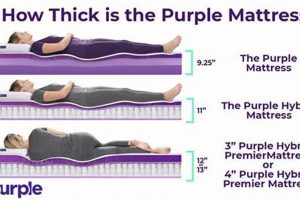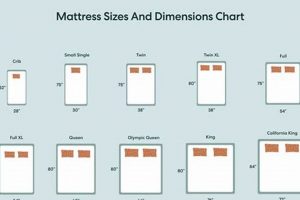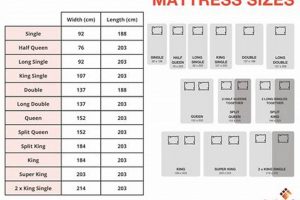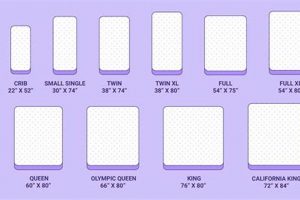A standard recreational vehicle queen mattress typically measures around 60 inches wide and 80 inches long. This dimensions allows for compatibility with many RV queen bed frames and provides a comfortable sleeping surface for two adults. However, variations exist; some RV queen mattresses, often referred to as “short queen” or “RV queen short,” are shorter in length, usually around 75 inches, to better accommodate the space constraints inherent in many RV models. It’s essential to measure the available space in the RV’s sleeping area before purchasing a mattress to ensure a proper fit.
Selecting the appropriate size sleeping platform is paramount for comfort and spatial efficiency within a recreational vehicle. Incorrect dimensions can lead to discomfort during sleep, impede movement within the RV, and even damage the bed frame or surrounding structures. Historically, RV manufacturers have utilized various mattress sizes to optimize space utilization, necessitating careful attention to dimensions when replacing or upgrading the sleeping arrangements.
The subsequent sections will explore different variations in dimensions for recreational vehicle queen mattresses, delve into factors influencing mattress thickness, and provide guidance on selecting a mattress material suited to individual needs and the unique environment of a recreational vehicle.
Essential Considerations for Recreational Vehicle Queen Mattress Dimensions
Optimizing comfort and space efficiency in a recreational vehicle necessitates careful consideration of mattress dimensions. The following tips provide guidance on selecting the appropriate mattress size and type.
Tip 1: Measure the Available Space: Before initiating a mattress purchase, meticulously measure the dimensions of the RV’s sleeping platform. Account for any obstructions, such as wheel wells or built-in furniture, that may impact the available space.
Tip 2: Identify the Existing Mattress Type: If replacing an existing mattress, determine whether it is a standard RV queen (60″ x 80″) or a short RV queen (60″ x 75″). This information will streamline the selection process.
Tip 3: Consider Mattress Thickness: Evaluate the available headroom within the sleeping area. A thicker mattress may compromise headroom, particularly in RVs with low ceilings. Balance comfort with spatial constraints.
Tip 4: Assess Weight Considerations: RVs have specific weight limitations. Research the weight of potential mattresses to ensure it does not exceed the RV’s maximum weight capacity, impacting fuel efficiency and handling.
Tip 5: Evaluate Material Durability: Select a mattress material that can withstand the fluctuating temperatures and humidity levels often encountered in recreational vehicles. Moisture-resistant materials are preferable.
Tip 6: Factor in Storage Requirements: If under-bed storage is a priority, ensure the chosen mattress height does not impede access to these storage areas. Prioritize functionality and accessibility.
Tip 7: Prioritize Comfort and Support: While space is a consideration, prioritize a mattress that provides adequate support and comfort for restful sleep. Consider memory foam or hybrid options for enhanced comfort.
Adhering to these guidelines will facilitate the selection of a recreational vehicle queen mattress that optimizes comfort, space utilization, and overall functionality within the RV environment.
The subsequent section will address common misconceptions regarding RV mattress sizes and explore the impact of mattress material on overall sleep quality.
1. Standard
The dimensions of 60 inches by 80 inches define the standardized “queen” size for recreational vehicle mattresses. This specific measurement provides a benchmark for manufacturers and consumers. Adherence to this standard offers compatibility across various RV models equipped with queen-sized bed frames. Deviation from this standard necessitates custom solutions or may lead to incompatibility, resulting in fitting issues and potential discomfort. For example, an RV designed for a standard queen mattress will not properly accommodate a full-size mattress, leaving gaps and compromising support. Conversely, attempting to force a larger mattress into the allotted space can damage the bed frame or the mattress itself.
Understanding the “60” x 80″” standard is critical for informed decision-making when replacing or upgrading an RV mattress. Failure to recognize this standard often results in purchasing an incorrect mattress size, leading to significant inconvenience and additional expenses. Many online retailers and brick-and-mortar stores offer “RV queen” mattresses that, while marketed as such, may deviate from the true standard. Therefore, verifying the actual dimensions before purchase is essential. Furthermore, the standard size dictates the availability of accompanying bedding, such as sheets and mattress protectors, making the 60″ x 80″ configuration more readily accessible and cost-effective than non-standard sizes.
In summary, the “60” x 80″” designation is the foundation for the definition of this type of mattress. Recognizing its importance allows for a seamless and well-informed purchase, ensuring proper fit, optimal comfort, and access to compatible bedding accessories within the recreational vehicle environment. The standard promotes uniformity and simplifies the selection process, mitigating potential problems associated with non-standard sizes. This adherence contributes significantly to a positive user experience.
2. Short
The 60″ x 75″ dimension, often referred to as a “short queen,” represents a variation within the realm of recreational vehicle queen mattresses. It serves as a space-saving alternative to the standard 60″ x 80″ dimensions, designed specifically to address spatial limitations commonly encountered in RV layouts. Its prevalence underscores the necessity of precise measurement and dimension awareness when selecting a mattress for a recreational vehicle.
- Spatial Optimization
The short queen configuration sacrifices 5 inches of length to offer increased maneuverability within the RV. This reduction in length is particularly beneficial in RV models where bedroom space is at a premium. For example, in Class B RVs or smaller travel trailers, the shorter mattress allows for easier passage around the bed and can free up valuable floor space, improving overall habitability.
- Weight Considerations
A shorter mattress inherently translates to a reduction in material, subsequently decreasing the overall weight. This is a significant consideration in RVs, where weight management directly impacts fuel efficiency and handling. The difference in weight between a standard and short queen mattress, while seemingly minor, can contribute to a cumulative weight reduction when combined with other weight-saving measures.
- Compatibility Assessment
Before purchasing a short queen mattress, a careful assessment of the existing bed frame is essential. While the width remains consistent at 60 inches, the 75-inch length must align with the frame’s dimensions to ensure proper support and prevent mattress overhang. Failure to properly assess compatibility can result in premature wear and tear on the mattress or structural damage to the bed frame.
- Bedding Selection
The 60″ x 75″ dimension necessitates the use of specifically sized bedding. Standard queen-sized sheets will be too large and create excess fabric, leading to discomfort and potential entanglement. Short queen-sized sheet sets are readily available, but their selection is often less diverse than that of standard queen bedding. This factor should be considered when weighing the advantages of a short queen mattress against the availability of desired bedding options.
The “Short: 60″ x 75″” designation signifies a purposeful deviation from the standard, driven by the practical requirements of RV living. Its selection hinges on a nuanced understanding of spatial constraints, weight management, compatibility considerations, and bedding availability. Ultimately, the choice between a standard and short queen mattress is a function of individual needs and the specific characteristics of the recreational vehicle.
3. Thickness Variation
Thickness variation represents a critical, yet often overlooked, element directly related to the overall utility of recreational vehicle queen mattresses. While the standard and short queen dimensions primarily address length and width, the thickness dictates comfort, support, and spatial harmony within the confined RV environment. The height of the mattress must be considered in conjunction with the existing bed frame and surrounding structures to prevent obstructions and maximize usability of the sleeping area. For instance, a mattress exceeding the allowable thickness may impede access to overhead storage compartments or create an uncomfortable sleeping position due to limited headroom. Different construction materials, such as memory foam, innerspring coils, or latex, inherently influence overall thickness. A memory foam mattress may compress over time, resulting in a perceived reduction in thickness, while an innerspring mattress typically maintains its height for an extended period. Therefore, the correlation between material composition and thickness variation should be carefully evaluated.
The choice of mattress thickness extends beyond mere convenience; it significantly impacts the ergonomic properties of the sleeping surface. A mattress that is too thin may fail to provide adequate spinal support, leading to discomfort and potential back pain. Conversely, an excessively thick mattress can elevate the sleeping surface to an uncomfortably high level, creating challenges for individuals with mobility limitations or those sharing the RV with pets. Consider a scenario where an RV owner replaces a 6-inch mattress with a 12-inch model without adequately assessing the available space. The resulting increase in bed height could obstruct access to under-bed storage, reduce headroom, and create difficulty getting in and out of bed. Such instances highlight the importance of carefully considering mattress thickness as a component when choosing sleeping solution.
In conclusion, thickness variation is not an independent attribute but rather an interconnected aspect that influences both the spatial efficiency and the ergonomic quality of a recreational vehicle queen mattress. A comprehensive understanding of this relationship, coupled with careful measurement and consideration of individual needs, is crucial for optimizing the sleeping experience and ensuring long-term satisfaction. By accounting for thickness alongside standard dimensional considerations, RV owners can mitigate potential challenges and cultivate a comfortable and functional living space.
4. Corner Radius
The corner radius, while seemingly a minor detail, plays a crucial role in ensuring a proper fit and optimal space utilization within a recreational vehicle. Its impact on the overall functionality and comfort should not be overlooked when considering the dimensions of sleeping solution.
- Accommodation of Curved Walls
Many RV interiors incorporate curved walls or rounded cabinetry to maximize space and improve aesthetics. A mattress with sharply defined corners may not seat correctly in these spaces, resulting in unsightly gaps, reduced support, and potential damage to both the mattress and the surrounding structures. A rounded corner radius, conversely, allows the mattress to conform more seamlessly to these curved surfaces, ensuring a snug and visually appealing fit. For example, in some Airstream models, the sleeping area features a distinct curvature. A mattress with square corners would necessitate custom alterations or result in significant wasted space.
- Ease of Movement and Accessibility
Sharp corners on a mattress can pose safety hazards, particularly in the confined spaces of an RV. They can obstruct movement, increase the risk of bumping into the edges, and potentially cause injury. A rounded corner radius mitigates these risks by softening the edges and facilitating smoother transitions within the living area. This is particularly important in RVs occupied by children or individuals with limited mobility, where the risk of accidental contact with sharp edges is heightened.
- Custom Mattress Considerations
When opting for a custom mattress, specifying the correct corner radius is paramount for achieving a precise fit. RV manufacturers often employ unique dimensions and corner geometries to optimize space utilization within their models. Providing accurate corner radius measurements to the mattress manufacturer ensures that the resulting mattress conforms perfectly to the available space, eliminating gaps and maximizing comfort. Failing to specify the corner radius can result in a mattress that does not seat correctly, compromising support and potentially damaging the bed frame.
- Aesthetic Harmony
A mattress with a corner radius that complements the overall design aesthetic of the RV contributes to a more visually harmonious and cohesive interior. Sharp, angular corners can appear jarring against the soft curves and rounded edges often found in RV interiors. A subtly rounded corner radius creates a more inviting and comfortable atmosphere, enhancing the overall appeal of the living space. This attention to detail reflects a commitment to quality and craftsmanship, elevating the overall experience of RV ownership.
The corner radius is an integral, albeit subtle, consideration when selecting a solution for sleeping within the constraints of a recreational vehicle. By carefully accounting for the corner radius in relation to the overall dimensions, RV owners can optimize space utilization, enhance safety, and cultivate a visually appealing and comfortable living environment, directly impacting the satisfaction and usability of the RV’s sleeping configuration.
5. Custom Dimensions
The concept of custom dimensions introduces a departure from standard RV mattress sizes, including the queen, necessitating precise measurement and tailored solutions to ensure optimal fit and comfort within the confines of a recreational vehicle. Understanding the factors that drive the need for custom dimensions is critical for RV owners seeking to maximize space utilization and create a personalized sleeping environment.
- Unique RV Layouts
Many recreational vehicles feature non-standard sleeping configurations, often dictated by space constraints or design choices. These unconventional layouts may necessitate mattresses with dimensions that deviate significantly from industry standards. For example, a vintage RV might have a curved sleeping platform or an unusually narrow sleeping area, rendering a standard mattress impractical. In such cases, custom dimensions become essential to achieve a proper fit and avoid wasted space.
- Slide-Out Mechanisms
Slide-out mechanisms, designed to expand the living space of an RV, can also introduce the need for custom-sized mattresses. When the slide-out is retracted, the available space for the mattress may be significantly reduced, requiring a shorter or narrower sleeping surface. Conversely, when the slide-out is extended, the bed frame may accommodate a larger mattress. Consequently, RV owners must consider the dimensions of the sleeping area in both retracted and extended positions when determining the appropriate mattress size, often necessitating a custom solution.
- Bed Frame Inconsistencies
Variations in bed frame construction can also contribute to the need for custom dimensions. RV manufacturers may employ different frame designs or alter dimensions over time, resulting in inconsistencies in mattress size requirements. Furthermore, some RV owners may modify or build their own bed frames, further deviating from standard dimensions. In these instances, a custom-sized mattress is the only way to ensure a proper fit and prevent mattress overhang or gaps.
- Personalized Comfort Preferences
Beyond spatial constraints, personal comfort preferences can also drive the decision to opt for custom dimensions. Some RV owners may prefer a longer or wider mattress to accommodate their sleeping habits or physical build. Others may require a thinner mattress to maximize headroom or access under-bed storage. By choosing custom dimensions, RV owners can tailor the mattress to their specific comfort needs, creating a more personalized and enjoyable sleeping experience.
The interplay between custom dimensions and standard sizes, particularly those defined within the context of “what size is a queen RV mattress,” underscores the importance of thorough measurement and careful consideration of individual needs. While standard sizes offer convenience and cost-effectiveness, custom dimensions provide a tailored solution for those seeking optimal fit, comfort, and space utilization within the unique environment of a recreational vehicle.
6. Under-bed Clearance
Under-bed clearance, the vertical distance between the bottom of the mattress and the floor or the base of the bed frame, is a critical consideration directly influenced by the size of sleeping solutions in recreational vehicles. Its relevance stems from its impact on storage capacity, accessibility, and overall spatial efficiency within the often-compact confines of an RV.
- Access to Storage Compartments
Sufficient clearance beneath a queen-sized mattress is essential for accessing storage compartments built into the bed frame. Inadequate clearance can render these compartments unusable, negating a valuable storage resource. For instance, if a thick queen mattress, whether standard or short, is used in conjunction with a low-profile bed frame, the available clearance may be insufficient to easily open storage drawers or lift the bed platform for accessing storage bins. This directly impacts the practicality of the RV’s design and reduces its storage capacity.
- Air Circulation and Moisture Control
Clearance beneath the mattress facilitates air circulation, which is vital for preventing moisture buildup and mold growth. In humid environments, inadequate airflow can trap moisture between the mattress and the bed frame, creating a breeding ground for mold and mildew. This is particularly pertinent in RVs, where temperature fluctuations and limited ventilation can exacerbate moisture-related issues. Adequate clearance ensures that air can circulate freely, reducing the risk of these problems and prolonging the lifespan of the mattress.
- Maintenance and Cleaning
Under-bed clearance influences the ease with which the area beneath the mattress can be cleaned and maintained. Insufficient clearance makes it difficult to remove debris, dust, and other contaminants, potentially contributing to allergens and odors within the RV. Adequate clearance allows for easy vacuuming or sweeping beneath the mattress, promoting a cleaner and healthier sleeping environment. Regular cleaning also helps to identify and address any potential issues, such as pest infestations or water leaks, before they escalate.
- Impact on Bed Height and Accessibility
The combination of mattress thickness and under-bed clearance determines the overall bed height, which directly impacts accessibility. A very high bed can be difficult for individuals with mobility limitations to get into and out of, while a very low bed can be uncomfortable for those with back problems. The interplay between mattress size and under-bed clearance must be carefully considered to achieve an optimal bed height that balances comfort, accessibility, and storage capacity. The appropriate combination allows for easier movement around the sleeping quarters.
In conclusion, under-bed clearance is an integral factor inextricably linked to its dimensions and related features. Achieving an optimal balance between clearance and mattress size, considering both functional and ergonomic needs, is paramount for maximizing the utility and comfort of the sleeping space in a recreational vehicle. Careful attention to these considerations ensures that the solution complements the overall design and enhances the RV living experience.
7. Weight Constraints
Weight constraints are a fundamental consideration when selecting a sleeping solution for a recreational vehicle. The physical dimensions directly correlate with the overall mass of the mattress, and exceeding weight limits compromises safety, fuel efficiency, and vehicle handling. Understanding these interdependencies is critical for responsible RV ownership.
- Impact on Fuel Efficiency
Increased weight directly reduces fuel efficiency. A heavier mattress requires the engine to expend more energy for propulsion, leading to higher fuel consumption over time. The cumulative effect of added weight, including the mattress, can significantly impact the overall cost of operation, particularly during long journeys. For instance, a difference of 50 pounds in mattress weight can translate to a noticeable increase in fuel costs over several thousand miles of travel.
- Effect on Vehicle Handling
Excessive weight can negatively impact vehicle handling and stability. A heavier load can affect the vehicle’s center of gravity, making it more susceptible to swaying and instability, especially during turns or in windy conditions. This can compromise safety and increase the risk of accidents. Distributing weight evenly throughout the RV is crucial, and minimizing unnecessary weight, including the mattress, contributes to improved handling and a safer driving experience.
- Adherence to Weight Ratings
Every RV has specified weight ratings, including Gross Vehicle Weight Rating (GVWR) and Cargo Carrying Capacity (CCC). Exceeding these ratings can damage the vehicle’s suspension, brakes, and tires, potentially leading to catastrophic failures. Selecting a mattress within the allowable weight limits ensures compliance with these ratings and protects the integrity of the vehicle. Ignoring weight ratings can invalidate warranties and create significant safety hazards.
- Material Composition and Weight
The material composition directly influences weight. Memory foam mattresses, while offering comfort, tend to be heavier than traditional innerspring mattresses. Latex mattresses represent another high-density option with substantial weight. When considering the dimensions in light of weight constraints, selecting lighter materials or opting for a shorter or thinner mattress can help minimize the overall load. Careful consideration of material density is crucial for balancing comfort with weight management.
In summary, weight constraints are inextricably linked to the dimensional aspects and material composition of a sleeping solution. Recognizing these interdependencies and adhering to weight ratings are essential for ensuring the safety, efficiency, and longevity of the recreational vehicle. A balanced approach, considering both comfort and weight management, is paramount for responsible RV ownership and a positive travel experience. The dimensions and materials selected can either contribute to or detract from the overall performance and safety of the RV.
Frequently Asked Questions
This section addresses common inquiries regarding the dimensions, variations, and selection criteria for recreational vehicle queen mattresses.
Question 1: What are the standard dimensions of a recreational vehicle queen mattress?
The standard dimensions are typically 60 inches in width and 80 inches in length.
Question 2: What is a “short queen” mattress, and how does it differ from a standard RV queen?
A “short queen” mattress measures 60 inches wide but only 75 inches long. This shorter length accommodates space limitations in some RV models.
Question 3: How does mattress thickness impact the suitability of a queen mattress for an RV?
Thickness affects headroom, access to storage, and overall comfort. Excessive thickness can obstruct movement or limit storage space.
Question 4: What role does corner radius play in mattress selection?
Corner radius ensures a proper fit within RVs featuring curved walls or rounded cabinetry. Sharp corners can create gaps and reduce support.
Question 5: Why might custom dimensions be necessary for an RV queen mattress?
Custom dimensions accommodate unique RV layouts, slide-out mechanisms, bed frame inconsistencies, and personalized comfort preferences.
Question 6: How do weight constraints influence the choice of an RV queen mattress?
Weight impacts fuel efficiency, vehicle handling, and adherence to weight ratings. Heavier mattresses can compromise performance and safety.
Careful consideration of these factors ensures a well-informed decision when selecting a suitable recreational vehicle sleeping surface.
The subsequent section explores the impact of mattress material on sleep quality and overall durability within the RV environment.
Conclusion
The preceding exploration of “what size is a queen rv mattress” has elucidated the multifaceted considerations inherent in selecting a suitable sleeping surface for recreational vehicles. From standardized dimensions to nuanced factors such as corner radius and weight constraints, a thorough understanding of spatial limitations, material properties, and vehicle-specific requirements is paramount. The pursuit of comfort must be tempered by the practical realities of RV ownership, emphasizing a balance between individual preferences and the constraints imposed by a mobile living environment.
The informed application of this knowledge empowers RV owners to make discerning choices, optimizing not only sleep quality but also the overall functionality and safety of their vehicles. By prioritizing dimensional accuracy and adhering to established weight ratings, one safeguards the longevity and performance of the RV while cultivating a more comfortable and enjoyable travel experience. Continued diligence in these areas ensures responsible RV ownership and promotes the sustainability of this lifestyle.


![Best Queen Size Foldable Mattress [Guide] Organic & Natural Mattress Buyer’s Guide: Non-Toxic Sleep Solutions Best Queen Size Foldable Mattress [Guide] | Organic & Natural Mattress Buyer’s Guide: Non-Toxic Sleep Solutions](https://mattressworldpa.com/wp-content/uploads/2025/07/th-2272-300x200.jpg)


![Best Queen Size Floor Mattress [Guide] Organic & Natural Mattress Buyer’s Guide: Non-Toxic Sleep Solutions Best Queen Size Floor Mattress [Guide] | Organic & Natural Mattress Buyer’s Guide: Non-Toxic Sleep Solutions](https://mattressworldpa.com/wp-content/uploads/2025/07/th-2269-300x200.jpg)

